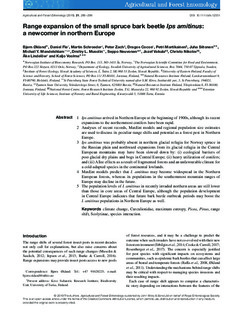| dc.contributor.author | Økland, Bjørn | |
| dc.contributor.author | Flø, Daniel | |
| dc.contributor.author | Schroeder, Martin | |
| dc.contributor.author | Zach, Peter | |
| dc.contributor.author | Cocos, Dragos | |
| dc.contributor.author | Martikainen, Petri | |
| dc.contributor.author | Siitonen, Juha | |
| dc.contributor.author | Mandelshtam, Michail Y. | |
| dc.contributor.author | Musolin, Dmitry L. | |
| dc.contributor.author | Neuvonen, Seppo | |
| dc.contributor.author | Vakula, Jozef | |
| dc.contributor.author | Nikolov, Christo | |
| dc.contributor.author | Lindelöw, Åke | |
| dc.contributor.author | Voolma, Kaljo | |
| dc.date.accessioned | 2019-11-11T12:24:01Z | |
| dc.date.available | 2019-11-11T12:24:01Z | |
| dc.date.created | 2019-03-21T16:57:22Z | |
| dc.date.issued | 2019 | |
| dc.identifier.citation | Agricultural and Forest Entomology. 2019, 1-13. | nb_NO |
| dc.identifier.issn | 1461-9555 | |
| dc.identifier.uri | http://hdl.handle.net/11250/2627716 | |
| dc.description.abstract | 1 Ips amitinus arrived in Northern Europe at the beginning of 1900s, although its recent expansions to the northernmost conifers have been rapid. 2 Analyses of recent records, MaxEnt models and regional population size estimates are used to discuss its peculiar range shifts and potential as a forest pest in Northern Europe. 3 Ips amitinus was probably absent in northern glacial refugia for Norway spruce in the Russian plain and northward expansions from its glacial refugia in the Central European mountains may have been slowed down by: (i) ecological barriers of post-glacial dry plains and bogs in Central Europe; (ii) heavy utilization of conifers; and (iii) Allee effects as a result of fragmented forests and an unfavourable climate for a cold-adapted species in the continental lowlands. 4 MaxEnt models predict that I. amitinus may become widespread in the Northern European forests, whereas its populations in the southernmost mountain ranges of Europe may decline in the future. 5 The population levels of I. amitinus in recently invaded northern areas are still lower than those in core areas of Central Europe, although the population development in Central Europe indicates that future bark beetle outbreak periods may boost the I. amitinus populations in Northern Europe as well. | nb_NO |
| dc.language.iso | eng | nb_NO |
| dc.rights | Navngivelse 4.0 Internasjonal | * |
| dc.rights.uri | http://creativecommons.org/licenses/by/4.0/deed.no | * |
| dc.subject | Climate change | nb_NO |
| dc.subject | Curculionidae | nb_NO |
| dc.subject | Maximum entropy | nb_NO |
| dc.subject | Picea | nb_NO |
| dc.subject | Pinus | nb_NO |
| dc.subject | Range shift | nb_NO |
| dc.subject | Scolytinae | nb_NO |
| dc.subject | Species interaction | nb_NO |
| dc.title | Range expansion of the small spruce bark beetle Ips amitinus: a newcomer in northern Europe | nb_NO |
| dc.type | Journal article | nb_NO |
| dc.type | Peer reviewed | nb_NO |
| dc.description.version | publishedVersion | nb_NO |
| dc.rights.holder | © 2019 The Authors | nb_NO |
| dc.subject.nsi | VDP::Landbruks- og Fiskerifag: 900::Landbruksfag: 910::Skogbruk: 915 | nb_NO |
| dc.source.pagenumber | 1-13 | nb_NO |
| dc.source.journal | Agricultural and Forest Entomology | nb_NO |
| dc.identifier.doi | 10.1111/afe.12331 | |
| dc.identifier.cristin | 1686824 | |
| dc.relation.project | Andre: VEGA 2-0012-17 (Slovakian part) | nb_NO |
| dc.relation.project | Andre: 17-04-01486 - Russian Foundation for Basic Research | nb_NO |
| dc.relation.project | Andre: 17-04-00360 - Russian Foundation for Basic Research | nb_NO |
| dc.relation.project | Andre: F0715 - Bo Rydins Foundation | nb_NO |
| dc.relation.project | Andre: 2016-20011 - Formas | nb_NO |
| dc.relation.project | Landbruks- og matdepartementet: 131090 | nb_NO |
| cristin.unitcode | 7677,3,0,0 | |
| cristin.unitname | Divisjon for bioteknologi og plantehelse | |
| cristin.ispublished | true | |
| cristin.fulltext | original | |
| cristin.qualitycode | 1 | |

